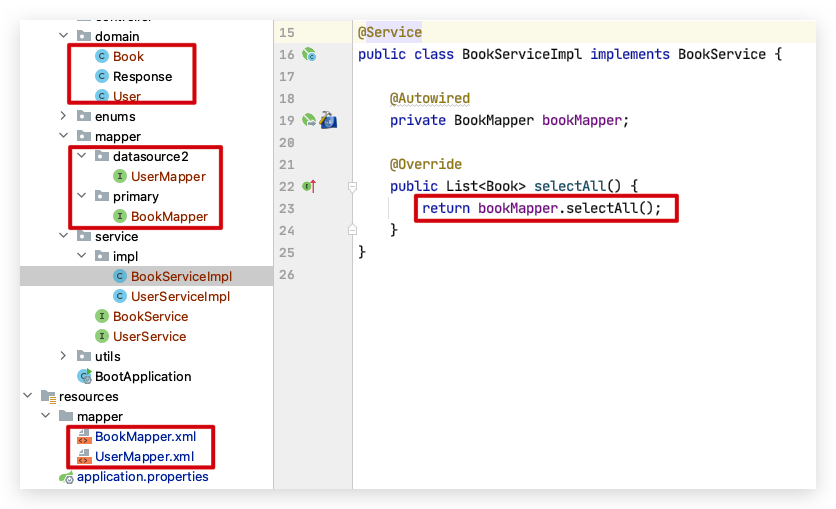最近在项目开发中,需要为一个使用 MysqL 数据库的 SpringBoot 项目,新添加一个 PLsql 数据库数据源,那么就需要进行 SpringBoot 的多数据源开发。代码很简单,下面是实现的过程。
环境准备
实验环境:
- JDK 1.8
- SpringBoot 2.4.1
- Maven 3.6.3
- MysqL 5.7
因为我本地只有 MysqL 数据库,为了方便演示,我会在启动一个本地 MysqL,在 MysqL 创建两个数据库,每个库中均有一个表,以此进行演示。
数据准备
本地 MysqL 端口默认不做改动,端口号 3306。
创建数据库 demo1,demo2。在 demo1 数据库中创建表 book。
-- create table
create table Book
(
id int auto_increment
primary key,author varchar(64) not null comment '作者信息',name varchar(64) not null comment '书籍名称',price decimal not null comment '价格',createTime datetime null comment '上架时间',description varchar(128) null comment '书籍描述'
);
-- insert data
INSERT INTO demo1.Book (id,author,name,price,createTime,description) VALUES (1,'金庸','笑傲江湖',13,'2020-12-19 15:26:51','武侠小说');
INSERT INTO demo1.Book (id,description) VALUES (2,'罗贯中','三国演义',14,'2020-12-19 15:28:36','历史小说');
在 demo2 数据库中创建表 user。
-- create table
create table User
(
id int auto_increment
primary key,name varchar(32) null comment '用户名称',birthday date null comment '出生日期'
)
comment '用户信息表';
-- insert data
INSERT INTO demo2.User (id,birthday) VALUES (1,'1924-03-10');
INSERT INTO demo2.User (id,birthday) VALUES (2,'1330-01-10');
数据准备完毕,表中都新增了两条数据。
项目准备
这里直接从 Spring 官方上初始化一个添加了 web、lombok、mybatis、MysqL 依赖的 SpringBoot 项目。
如果你手上已经有了一个 SpringBoot 项目,既然你想改造成多数据源,那么你应该已经有了一个数据源了,如果新增的数据源数据库和目前的一致,你可以直接使用你的项目进行改造测试。
多数据源
SpringBoot 的多数据源开发十分简单,如果多个数据源的数据库相同,比如都是 MysqL,那么依赖是不需要任何改动的,只需要进行多数据源配置即可。
如果你新增的数据库数据源和目前的数据库不同,记得引入新数据库的驱动依赖,比如 MysqL 和 PGsql。
<dependency>
<groupId>MysqL</groupId>
<artifactId>MysqL-connector-java</artifactId>
<scope>runtime</scope>
</dependency>
<dependency>
<groupId>org.postgresql</groupId>
<artifactId>postgresql</artifactId>
<version>42.2.7</version>
</dependency>
连接配置
既然有多个数据源,因为数据库用户名密码可能不相同,所以是需要配置多个数据源信息的,直接在 properties/yml 中配置即可。这里要注意根据配置的属性名进行区分,同时因为数据源要有一个默认使用的数据源,最好在名称上有所区分(这里使用 primary 作为主数据源标识)。
########################## 主数据源 ##################################
spring.datasource.primary.jdbc-url=jdbc:MysqL://127.0.0.1:3306/demo1?characterEncoding=utf-8&serverTimezone=GMT%2B8
spring.datasource.primary.driver-class-name=com.MysqL.jdbc.Driver
spring.datasource.primary.username=root
spring.datasource.primary.password=
########################## 第二个数据源 ###############################
spring.datasource.datasource2.jdbc-url=jdbc:MysqL://127.0.0.1:3306/demo2?characterEncoding=utf-8&serverTimezone=GMT%2B8
spring.datasource.datasource2.driver-class-name=com.MysqL.jdbc.Driver
spring.datasource.datasource2.username=root
spring.datasource.datasource2.password=
# mybatis
mybatis.mapper-locations=classpath:mapper/*.xml
mybatis.type-aliases-package=com.wdbyte.domain
注意,配置中的数据源连接 url 末尾使用的是 jdbc-url.
因为使用了 Mybatis 框架,所以 Mybatis 框架的配置信息也是少不了的,指定扫描目录 mapper 下的mapper xml 配置文件。
Mybatis 配置
如何编写 Mybatis Mapper 或者如何使用工具生成 Mybatis Mapper 不是本文的重点,如果你不知道可以参考 Mybatis 官方文档或者我之前的文章。
链接二:使用 Mybatis 集成 pagehelper 分页插件和 mapper 插件
下面我已经按照上面的两个库中的两个表,Book 和 User 表分别编写相应的 Mybatis 配置。
创建 BookMapper.xml 和 UserMapper.xml 放到配置文件配置的路径 mapper 目录下。创建 UserMapper 和 BookMapper 接口操作类放在不同的目录。这里注意 Mapper 接口要按数据源分开放在不同的目录中。后续好使用不同的数据源配置扫描不同的目录,这样就可以实现不同的 Mapper 使用不同的数据源配置。

Service 层没有变化,这里 BookMapper 和 UserMapper 都有一个 selectAll() 方法用于查询测试。
多数据源配置
上面你应该看到了,到目前为止和 Mybatis 单数据源写法唯一的区别就是 Mapper 接口使用不同的目录分开了,那么这个不同点一定会在数据源配置中体现。
主数据源
开始配置两个数据源信息,先配置主数据源,配置扫描的 MapperScan 目录为 com.wdbyte.mapper.primary
/**
* 主数据源配置
*
* @author niujinpeng
* @website: https://www.wdbyte.com
* @date 2020/12/19
*/
@Configuration
@MapperScan(basePackages = {"com.wdbyte.mapper.primary"},sqlSessionFactoryRef = "sqlSessionFactory")
public class PrimaryDataSourceConfig {
@Bean(name = "dataSource")
@ConfigurationProperties(prefix = "spring.datasource.primary")
@Primary
public DataSource dataSource() {
return DataSourceBuilder.create().build();
}
@Bean(name = "sqlSessionFactory")
@Primary
public sqlSessionFactory sqlSessionFactory(@Qualifier("dataSource") DataSource dataSource) throws Exception {
sqlSessionfactorybean bean = new sqlSessionfactorybean();
bean.setDataSource(dataSource);
bean.setMapperLocations(new PathMatchingResourcePatternResolver().getResources("classpath:mapper/*.xml"));
return bean.getObject();
}
@Bean(name = "transactionManager")
@Primary
public DataSourceTransactionManager transactionManager(@Qualifier("dataSource") DataSource dataSource) {
return new DataSourceTransactionManager(dataSource);
}
@Bean(name = "sqlSessionTemplate")
@Primary
public sqlSessionTemplate sqlSessionTemplate(@Qualifier("sqlSessionFactory") sqlSessionFactory sqlSessionFactory) {
return new sqlSessionTemplate(sqlSessionFactory);
}
}
和单数据源不同的是这里把
都单独进行了配置,简单的 bean 创建,下面是用到的一些注解说明。
-
@ConfigurationProperties(prefix = "spring.datasource.primary"):使用spring.datasource.primary 开头的配置。 -
@Primary:声明这是一个主数据源(默认数据源),多数据源配置时必不可少。 -
@Qualifier:显式选择传入的 Bean。
第二个数据源
第二个数据源和主数据源唯一不同的只是 MapperScan 扫描路径和创建的 Bean 名称,同时没有 @Primary 主数据源的注解。
/**
* 第二个数据源配置
*
* @author niujinpeng
* @website: https://www.wdbyte.com
* @date 2020/12/19
*/
@Configuration
@MapperScan(basePackages = {"com.wdbyte.mapper.datasource2"},sqlSessionFactoryRef = "sqlSessionFactory2")
public class SecondDataSourceConfig {
@Bean(name = "dataSource2")
@ConfigurationProperties(prefix = "spring.datasource.datasource2")
public DataSource dataSource() {
return DataSourceBuilder.create().build();
}
@Bean(name = "sqlSessionFactory2")
public sqlSessionFactory sqlSessionFactory(@Qualifier("dataSource2") DataSource dataSource) throws Exception {
sqlSessionfactorybean bean = new sqlSessionfactorybean();
bean.setDataSource(dataSource);
bean.setMapperLocations(new PathMatchingResourcePatternResolver().getResources("classpath:mapper/*.xml"));
return bean.getObject();
}
@Bean(name = "transactionManager2")
public DataSourceTransactionManager transactionManager(@Qualifier("dataSource2") DataSource dataSource) {
return new DataSourceTransactionManager(dataSource);
}
@Bean(name = "sqlSessionTemplate2")
public sqlSessionTemplate sqlSessionTemplate(@Qualifier("sqlSessionFactory2") sqlSessionFactory sqlSessionFactory) {
return new sqlSessionTemplate(sqlSessionFactory);
}
}
注意:因为已经在两个数据源中分别配置了扫描的 Mapper 路径,如果你之前在 SpringBoot 启动类中也使用了 Mapper 扫描注解,需要删掉。
访问测试
编写两个简单的查询 Controller 然后进行访问测试。
// BookController
@RestController
public class BookController {
@Autowired
private BookService bookService;
@GetMapping(value = "/books")
public Response selectAll() throws Exception {
List<Book> books = bookService.selectAll();
return ResponseUtill.success(books);
}
}
// UserController
@RestController
public class UserController {
@Autowired
private UserService userService;
@ResponseBody
@GetMapping(value = "/users")
public Response selectAll() {
List<User> userList = userService.selectAll();
return ResponseUtill.success(userList);
}
}
访问测试,我这里直接 CURL 请求。
➜ ~ curl localhost:8080/books
{
"code": "0000","message": "success","data": [
{
"id": 1,"author": "金庸","name": "笑傲江湖","price": 13,"createtime": "2020-12-19T07:26:51.000+00:00","description": "武侠小说"
},{
"id": 2,"author": "罗贯中","name": "三国演义","price": 14,"createtime": "2020-12-19T07:28:36.000+00:00","description": "历史小说"
}
]
}
➜ ~ curl localhost:8080/users
{
"code": "0000","name": "金庸","birthday": "1924-03-09T16:00:00.000+00:00"
},"name": "罗贯中","birthday": "1330-01-09T16:00:00.000+00:00"
}
]
}
➜ ~
至此,多数据源配置完成,测试成功。
连接池
其实在多数据源改造中,我们一般情况下都不会使用默认的 JDBC 连接方式,往往都需要引入连接池进行连接优化,不然你可能会经常遇到数据源连接被断开等报错日志。其实数据源切换连接池数据源也是十分简单的,直接引入连接池依赖,然后把创建 dataSource 的部分换成连接池数据源创建即可。
下面以阿里的 Druid 为例,先引入连接池数据源依赖。
<dependency>
<groupId>com.alibaba</groupId>
<artifactId>druid</artifactId>
</dependency>
添加 Druid 的一些配置。
spring.datasource.datasource2.initialSize=3 # 根据自己情况设置
spring.datasource.datasource2.minIdle=3
spring.datasource.datasource2.maxActive=20
改写 dataSource Bean 的创建代码部分。
@Value("${spring.datasource.datasource2.jdbc-url}")
private String url;
@Value("${spring.datasource.datasource2.driver-class-name}")
private String driverClassName;
@Value("${spring.datasource.datasource2.username}")
private String username;
@Value("${spring.datasource.datasource2.password}")
private String password;
@Value("${spring.datasource.datasource2.initialSize}")
private int initialSize;
@Value("${spring.datasource.datasource2.minIdle}")
private int minIdle;
@Value("${spring.datasource.datasource2.maxActive}")
private int maxActive;
@Bean(name = "dataSource2")
public DataSource dataSource() {
DruidDataSource dataSource = new DruidDataSource();
dataSource.setUrl(url);
dataSource.setDriverClassName(driverClassName);
dataSource.setUsername(username);
dataSource.setPassword(password);
dataSource.setInitialSize(initialSize);
dataSource.setMinIdle(minIdle);
dataSource.setMaxActive(maxActive);
return dataSource;
}
这里只是简单的提一下使用连接池的重要性,Druid 的详细用法还请参考官方文档。
文中代码已经上传到 Github: https://github.com/niumoo/springboot
最后的话
文章有帮助可以点个「赞」或「分享」,都是支持!
文章每周持续更新,可以关注「 未读代码 」公众号或者我的博客。


